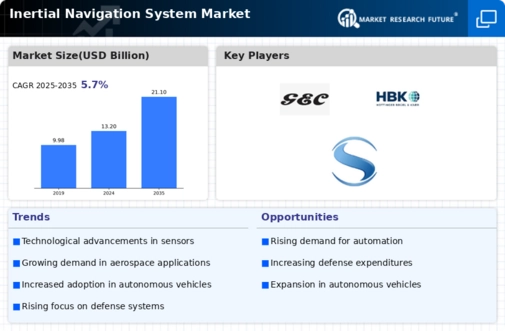Top Industry Leaders in the Inertial Navigation System Market

Inertial Navigation System Market
Competitive Landscape
General Electric Company
Gladiator Technologies Inc.
Honeywell International Inc.
Lord Microstrain
Northrop Grumman Corporation
Safran Electronics & Defense
Strategies Adopted
Current investment trends in the INS industry underscore a focus on research and development, commercialization, and market expansion. Key players are directing investments towards developing next-generation INS technologies, enhancing system performance, and expanding product portfolios to address evolving customer requirements. Investments in MEMS sensor technology, artificial intelligence, and digital signal processing are prevalent, reflecting the industry's commitment to innovation and continuous improvement. Additionally, strategic investments in manufacturing capabilities, supply chain optimization, and talent acquisition aim to strengthen market position and ensure the timely delivery of INS solutions to customers worldwide.
The overall competitive scenario in the INS market is characterized by established navigation system manufacturers, technology providers, and start-ups, each navigating the industry with distinct strategies. Market share analysis considers factors such as navigation accuracy, reliability, size, weight, and power consumption. The industry's responsiveness to evolving customer needs, technological advancements, and market dynamics further shapes competitiveness. As demand for precise navigation solutions continues to rise, companies in this sector are focused on delivering innovative, reliable, and cost-effective INS solutions that enable safe and efficient navigation across various domains, driving growth and advancement in the global navigation market.
Emerging Companies
As the demand for INS systems continues to grow, new and emerging companies are entering the market, contributing to innovation and specialization. Start-ups and specialized firms such as VectorNav Technologies, KVH Industries, and Advanced Navigation are gaining recognition by providing innovative INS solutions tailored to specific industry needs. These companies leverage expertise in MEMS sensors, sensor fusion algorithms, and miniaturization techniques to develop compact and cost-effective INS systems suitable for UAVs, autonomous vehicles, and wearable devices. The industry is witnessing a trend towards the integration of complementary technologies such as GNSS, LiDAR, and computer vision to enhance navigation accuracy and resilience in challenging environments.
Industry news within the INS market reflects ongoing trends, regulatory changes, and technological advancements driving the sector forward. News related to successful INS deployments, new product launches, and strategic collaborations showcase advancements in navigation technology and system integration. Moreover, developments in autonomous navigation, urban air mobility initiatives, and next-generation positioning systems are frequently covered in industry news, highlighting the transformative potential of INS technology in various applications. Additionally, news related to industry partnerships, government contracts, and international collaborations underscore the global nature of the INS market and the collective efforts aimed at advancing navigation capabilities worldwide.
Recent News
Honeywell Aerospace (USA):
Focus on Next-Generation INS Technology: Honeywell unveils its HG4930 ring laser gyro (RLG) based INS, offering enhanced accuracy, stability, and performance for demanding aerospace applications.
Partnership with Boeing: Honeywell collaborates with Boeing on integrating its INS technology into next-generation aircraft for improved navigation and safety.
Northrop Grumman (USA):
Emphasis on High-Precision Military INS: Northrop Grumman develops and supplies high-precision military INS for submarines, satellites, and other tactical platforms, ensuring navigation accuracy in GPS-denied environments.
Focus on Space Applications: Northrop Grumman's INS technology plays a crucial role in spacecraft navigation and positioning, supporting critical space missions.
Teledyne Technologies (USA):
Focus on Cost-Effective and Compact INS Solutions: Teledyne offers a range of affordable and compact INS solutions for commercial drones, unmanned vehicles, and maritime applications.
Emphasis on Microelectromechanical Systems (MEMS) Technology: Teledyne utilizes MEMS technology in its INS, offering improved affordability and miniaturization for diverse applications.
Leonardo DRS (USA):
Focus on Integrated Navigation and Positioning Systems: Leonardo DRS develops integrated navigation and positioning systems combining INS with GPS, radar, and other sensors for enhanced accuracy and redundancy.
Emphasis on Cybersecurity: Leonardo DRS prioritizes cybersecurity in its INS technology, protecting against spoofing and jamming attempts in critical navigation systems.
Safran Electronics & Defense (France):
Focus on High-Performance INS for Aircraft and Missiles: Safran develops high-performance INS for fighter jets, helicopters, and missiles, contributing to superior navigational capabilities and weapon accuracy.
Emphasis on International Partnerships: Safran collaborates with leading aerospace and defense companies worldwide to provide INS solutions for international customers.










